
List of Dartmouth College buildings
Encyclopedia
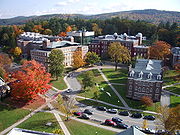
Dartmouth College
Dartmouth College is a private, Ivy League university in Hanover, New Hampshire, United States. The institution comprises a liberal arts college, Dartmouth Medical School, Thayer School of Engineering, and the Tuck School of Business, as well as 19 graduate programs in the arts and sciences...
is located in the rural town of Hanover
Hanover, New Hampshire
Hanover is a town along the Connecticut River in Grafton County, New Hampshire, United States. The population was 11,260 at the 2010 census. CNN and Money magazine rated Hanover the sixth best place to live in America in 2011, and the second best in 2007....
in the Upper Valley of the Connecticut River
Connecticut River
The Connecticut River is the largest and longest river in New England, and also an American Heritage River. It flows roughly south, starting from the Fourth Connecticut Lake in New Hampshire. After flowing through the remaining Connecticut Lakes and Lake Francis, it defines the border between the...
in the New England
New England
New England is a region in the northeastern corner of the United States consisting of the six states of Maine, New Hampshire, Vermont, Massachusetts, Rhode Island, and Connecticut...
state of New Hampshire
New Hampshire
New Hampshire is a state in the New England region of the northeastern United States of America. The state was named after the southern English county of Hampshire. It is bordered by Massachusetts to the south, Vermont to the west, Maine and the Atlantic Ocean to the east, and the Canadian...
. Dartmouth's 269 acre campus centered on The Green
The Green (Dartmouth College)
The Green is a grass-covered field and common space at the center of Dartmouth College, an Ivy League university located in Hanover, New Hampshire, United States. It was among the first parcels of land obtained by the College upon its founding in 1769, and is the only creation of the 18th century...
makes the institution the largest private landowner of the town of Hanover, and its landholdings and facilities are valued at an estimated $419 million. Dartmouth's campus buildings vary in age from several early 19th century buildings to a number of ongoing construction projects. Most of Dartmouth's buildings are designed in the Georgian
Georgian architecture
Georgian architecture is the name given in most English-speaking countries to the set of architectural styles current between 1720 and 1840. It is eponymous for the first four British monarchs of the House of Hanover—George I of Great Britain, George II of Great Britain, George III of the United...
style, a theme which has been preserved in recent architectural additions.
Academic and administrative buildings
| Building | Image | Constructed | Notes | Reference |
|---|---|---|---|---|
| 44 North College Street |  |
1855 or earlier | 44 North College Street was privately owned until at least 1954. Under the College's stewardship, it has served as a Russian language immersion house and an international students' house. Currently, it houses Off-Campus Programs. | |
| Baker Memorial Library Baker Memorial Library Fisher Ames Baker Memorial Library is the main library at Dartmouth College in Hanover, New Hampshire. The fresco, The Epic of American Civilization, was painted by José Clemente Orozco in the lower level of Baker Library... |
 |
1928 | Baker Library was built to replace the Wilson Hall library with money donated by George Fisher Baker in memory of his uncle, Fisher Ames Baker. The Reserve Corridor in the basement are decorated by a fresco by José Clemente Orozco José Clemente Orozco José Clemente Orozco was a Mexican social realist painter, who specialized in bold murals that established the Mexican Mural Renaissance together with murals by Diego Rivera, David Alfaro Siqueiros, and others... called The Epic of American Civilization. Baker's iconic 200 feet (61 m) tower is often used as a symbolic representation of the College. |
|
| Bartlett Hall |  |
1890–1891 | Bartlett Hall was originally constructed as the College's YMCA YMCA The Young Men's Christian Association is a worldwide organization of more than 45 million members from 125 national federations affiliated through the World Alliance of YMCAs... headquarters. Today it houses the Department of Asian and Middle Eastern Languages and Literatures and the Program in Asian and Middle Eastern Studies. |
|
| Berry Library |  |
1998–2000 | Berry Library is an 80000 square feet (7,432.2 m²) addition to Baker Memorial Library, named for George Berry. It stands on the site of the 1931 Dragon Hall, among other buildings. | |
| Burke Laboratory |  |
1993–1994 | Part of the Sherman Fairchild Physical Sciences Center, the Burke Laboratory is adjoined to the Fairchild Building and currently houses the Chemistry Department offices and laboratories. | |
| Carpenter Hall |  |
1929 | Carpenter currently houses the Art History Department, its Sherman Art Library, and the Program in Women's and Gender Studies. | |
| Carson Hall |  |
2002 | Carson Hall, connected to Berry Library, houses the History Department. | |
| Clement Hall |  |
1914 | Originally built as an auto garage, Clement now houses art studios and workspace. | |
| Dartmouth Hall | 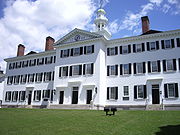 |
1904–1906 | The original Dartmouth Hall, constructed in 1784, was the oldest College building until it burned in 1904. It was reconstructed the following year, and its replacement houses the Department of French and Italian Languages and Literatures, Department of German Studies, and Department of Spanish and Portuguese Languages and Literatures. | |
| Charles Gilman Life Sciences Laboratory |  |
1964 | Gilman houses the Biological Sciences Department and is connected to the Dartmouth Medical School Dartmouth Medical School Dartmouth Medical School is the medical school of Dartmouth College, located in Hanover, New Hampshire, in the United States. The fourth-oldest medical school in the United States, Dartmouth Medical School was founded in 1797 by New England physician Nathan Smith and grew steadily over the course... . |
|
| Haldeman Center |  |
2004–2006 | The Haldeman Center houses the Institute for the Study of Applied and Professional Ethics, the Fannie and Alan Leslie Center for the Humanities at Dartmouth College, and The John Sloan Dickey John Sloan Dickey John Sloan Dickey was an American diplomat, scholar, and intellectual. Dickey served as President of Dartmouth College, Hanover, New Hampshire, from 1945 to 1970, and helped revitalize the Ivy League institution.... Center for International Understanding. |
|
| Hopkins Center for the Creative and Performing Arts Hopkins Center for the Arts Hopkins Center for the Creative and Performing Arts at Dartmouth College is located at 2 East Wheelock Street in Hanover, New Hampshire. The center, which was designed by Wallace K. Harrison and foreshadows his later design of Manhattan’s Lincoln Center, is the college’s cultural hub. It is home... |
 |
1962 | Designed by famed architect Wallace Harrison Wallace Harrison Wallace Kirkman Harrison , was an American architect.-Career:Harrison started his professional career with the firm of Corbett, Harrison & MacMurray, participating in the construction of Rockefeller Center... , the Hopkins Center ("the Hop") houses Dartmouth's Music, Studio Art, and Theater departments. It also contains several auditoriums, a dining facility, and the Paddock Music Library. |
|
| Kemeny Hall |  |
2004–2006 | Kemeny Hall is the home of the Mathematics Department, which had previously been scattered among multiple buildings for more than 25 years. | |
| McNutt Hall |  |
1902–1904 | Originally named Tuck Hall, McNutt housed the Tuck School of Business Tuck School of Business The Amos Tuck School of Business Administration is the graduate business school of Dartmouth College in Hanover, New Hampshire, in the United States... until 1930. Today, the building houses the Office of Undergraduate Admissions, the Office of the Registrar, and Student Financial Services. |
|
| Moore Hall |  |
1996–1998 | Moore Hall houses the Psychological and Brain Sciences Department. | |
| Parkhurst Hall |  |
1911 | This building houses administrative offices, including the Office of the President, Office of the Provost, Office of the Dean of the College, and Office of Undergraduate Judicial Affairs. | |
| Raven House |  |
1944 or later | Raven was built as a "convalescent home" for patients of the hospital that formerly stood nearby. In 1989, Dartmouth purchased the building and converted it to use for computing administration. It also houses the Department of Education. | |
| Reed Hall |  |
1839–1840 | Reed was originally constructed to house Dartmouth's library, which was previously located in the nearby Dartmouth Hall. In the late 19th century, it came to be used partially as a dormitory, and today is home to the Department of Classics, Department of Russian Language and Literature, Comparative Literature Program, Jewish Studies Program, and Linguistics and Cognitive Science Program. | |
| Rockefeller Hall |  |
1983 | Named after U.S. Vice President and Dartmouth alumnus Nelson Rockefeller Nelson Rockefeller Nelson Aldrich Rockefeller was the 41st Vice President of the United States , serving under President Gerald Ford, and the 49th Governor of New York , as well as serving the Roosevelt, Truman and Eisenhower administrations in a variety of positions... , this annex to Silsby Hall contains the Department of Economics and the Nelson A. Rockefeller Center for Public Policy and the Social Sciences. |
|
| Sanborn House |  |
1929 | Sanborn House houses the English Department. | |
| Shattuck Observatory Shattuck Observatory Shattuck Observatory is the astronomical observatory of Dartmouth College in Hanover, New Hampshire. It is a small building with three wings and a two-story dome . Its foundations are granite blocks; the building itself is brick. It is notable as the oldest scientific building on campus... |
 |
1854 | Shattuck is an observatory Observatory An observatory is a location used for observing terrestrial or celestial events. Astronomy, climatology/meteorology, geology, oceanography and volcanology are examples of disciplines for which observatories have been constructed... and is the oldest scientific building at Dartmouth. It stands on a hill behind the Sherman Fairchild Physical Sciences Center. |
|
| Fairchild Building |  |
1972–1974 | Part of the Sherman Fairchild Physical Sciences Center, the Fairchild Building houses the Department of Geography and the Department of Earth Sciences. | |
| Sherman House |  |
1883 | Originally the home of Dartmouth professor Frank A. Sherman, the Sherman House belonged to Sigma Phi Epsilon fraternity from 1928 until the 1950s. Today, it houses Dartmouth's Native American Studies Program. | |
| Silsby Hall |  |
1927–1928 | Silsby Hall currently houses the Department of Anthropology, Department of Government, and Department of Sociology, Program in African and African-American Studies, Program in Latin American, Latino, and Caribbean Studies, and Program in Mathematics and Social Sciences. | |
| Steele Chemistry Building |  |
1920–1921 | Part of the Sherman Fairchild Physical Sciences Center, the Steele Building used to house the Chemistry department until its move to Burke Laboratory. It is used by the Department of Earth Sciences now and is home to the Environmental Studies Program and the Geochemistry laboratories. | |
| Sudikoff Laboratory |  |
1968 | Originally the mental health facility for the hospital that formerly stood nearby, Sudikoff now houses Computer Science and its laboratories. | |
| Thornton Hall |  |
1828–1829 | Thornton Hall was originally a dormitory. Today, it houses the Religion and Philosophy departments. | |
| Webster Hall |  |
1901–1907 | Originally an auditorium and concert hall, Webster Hall was temporarily home to the town's Nugget Theater and served as the location for Commencement ceremonies from 1908-1930. In 1998, the building was redesigned to house the Rauner Special Collections Library. | |
| Wentworth Hall |  |
1828–1829 | Wentworth served as a dormitory until 1912, when major internal reconstruction transformed it into academic and office space. | |
| Wilder Hall |  |
1897–1899 | Part of the Sherman Fairchild Physical Sciences Center, Wilder Hall houses the Physics and Astronomy Department. | |
| Wilson Hall |  |
1884–1885 | Wilson was built as the first library building of the College. It later housed the anthropology department and the College museum, before the latter was moved to the Hood Museum of Art Hood Museum of Art The Hood Museum of Art is a museum in Hanover, New Hampshire, USA. Dating back to 1772, the museum is owned and operated by Dartmouth College and is connected to the Hopkins Center for the Arts. The current building, designed by Charles Willard Moore and Chad Flloyd, opened in the fall of 1985. It... . Currently, Wilson houses film studios, the Film and Media Studies Department, and a practice hall. |
Residential buildings
As opposed to ungrouped dormitories or "residential collegeResidential college
A residential college is an organisational pattern for a division of a university that places academic activity in a community setting of students and faculty, usually at a residence and with shared meals, the college having a degree of autonomy and a federated relationship with the overall...
s" as employed at such institutions as Yale University
Yale University
Yale University is a private, Ivy League university located in New Haven, Connecticut, United States. Founded in 1701 in the Colony of Connecticut, the university is the third-oldest institution of higher education in the United States...
or Princeton University
Princeton University
Princeton University is a private research university located in Princeton, New Jersey, United States. The school is one of the eight universities of the Ivy League, and is one of the nine Colonial Colleges founded before the American Revolution....
(in imitation of the colleges of Cambridge
University of Cambridge
The University of Cambridge is a public research university located in Cambridge, United Kingdom. It is the second-oldest university in both the United Kingdom and the English-speaking world , and the seventh-oldest globally...
and Oxford
University of Oxford
The University of Oxford is a university located in Oxford, United Kingdom. It is the second-oldest surviving university in the world and the oldest in the English-speaking world. Although its exact date of foundation is unclear, there is evidence of teaching as far back as 1096...
), Dartmouth residence halls are grouped into nine "communities," each composed of one to three "clusters" of dormitories. Dartmouth houses approximately 3,300 students in its facilities, or about 85% of the student body; the remaining 15% opt to live in off-campus housing. The Housing Office consists of three employees that house students four times a year (not including the interim period), due to the college's enrollment plan (the "D-Plan").
Every cluster or group of clusters is administered by a live-in Community Director. Approximately one-third of the rooms are singles; the remaining rooms vary among "one, two, and three-room doubles, one, two, and three-room triples, two, three, and four-room quads, apartments and suites."
Affinity programs
Affinity programs are a housing option for Dartmouth students, described as "residentially-based, educationally-purposeful living opportunities for residents that center around a self-defined Academic or Special Interest programmatic focus." Some affinity programs are housed in sections or on floors of larger dormitories; those listed below are only the programs in their own free-standing structures.| Building | Image | Constructed | Capacity | Notes | Reference |
|---|---|---|---|---|---|
| Chinese Language House |  |
1951 | 8 | The building was built as a residence for the headmaster of the Clark Preparatory School Clark Preparatory School Clark Preparatory School was a boys-only independent boarding school located in Hanover, New Hampshire, USA. It was founded in 1919 by Dr. Clifford Pease Clark, and its headmaster was Dr. Frank Millett Morgan, both of whom were former members of the faculty of nearby Dartmouth College... . It became the Asian Studies Center in 1985 and the Chinese Language House in 2007. |
|
| Brewster Hall |  |
1938 | 26 | Originally constructed to house employees of the Hanover Inn, Brewster Hall also served as the house for Epsilon Kappa Theta sorority before hosting the International House in 1994. | |
| Cutter Hall |  |
1938 | 26 | Cutter Hall was built for the Clark Preparatory School and purchased by Dartmouth in 1953. Since 1970, it has been the home of the Afro-American Society and El-Hajj Malik El-Shabazz Center for Intellectual Inquiry. | |
| Foley House |  |
1931 or later | 10 | By the mid-1980s, Dartmouth had acquired this privately owned building and began using it as an Outward Bound Outward Bound Outward Bound is an international, non-profit, independent, outdoor educationorganization with approximately 40 schools around the world and 200,000 participants per year... House. Foley House houses the Foley Cooperative, where residents communally participate in cooking, eating, and household chores. |
|
| La Casa |  |
1820 ca. | 10 | This house was initially operated as a private hospital before coming into the hands of private citizens, including a Dean of the Thayer School of Engineering Thayer School of Engineering Thayer School of Engineering is a graduate school at Dartmouth College, Hanover, New Hampshire, United States, whose faculty also double as the undergraduate Department of Engineering Sciences. The school was established in 1867 with funds from Brig. Gen... . The College acquired it around 1936. La Casa is an affinity house for students interested in Spanish languages and cultures. |
|
| Native American House |  |
1852 | 16 | This structure first served as a bakery and confectionery. In the early 20th century, it was owned by Lambda Chi Alpha and Pi Lambda Theta fraternities. During the 1960s, it became the Occom Inn, before finally being purchased by the College in 1993. It now serves as the Native American House, providing "cultural, social and educational enrichment for Native and other Dartmouth students." | |
| Pike House |  |
1874 | 14 | This building served as a dormitory until the 1920s, also housing Epsilon Kappa Phi fraternity. Since 1999, it has been known as the Latin American, Latino and Caribbean (LALACS) House. |
The Choate Cluster
The modernist Choate Cluster is an all-freshman residence cluster principally consisting of Bissell, Brown, Cohen and Little, part of an "experiment in student living". The cluster includes four dormitories and two lounges. Each pair of T-shaped dorms is attached to a single lounge via glass-enclosed above-ground walkways that are referred to as "hamster tunnels". The dorms include one-room doubles and one-room singles. Each dorm is three floors high and connected to the lounge on the second floor. The cluster was constructed on land acquired from Cardigan Mountain SchoolCardigan Mountain School
Cardigan Mountain School is a boys-only independent boarding school located on 62 Alumni Drive, Canaan, New Hampshire, USA. It was founded in 1945 on land provided by Dartmouth College....
and was the first major construction project of John Sloan Dickey
John Sloan Dickey
John Sloan Dickey was an American diplomat, scholar, and intellectual. Dickey served as President of Dartmouth College, Hanover, New Hampshire, from 1945 to 1970, and helped revitalize the Ivy League institution....
's presidency. The cluster cost $1.5 million to build, and was partially funded by the U.S. Housing and Home Finance Administration.
The nearby North Hall is administratively part of the cluster, but was not constructed at the same time, and does not house freshmen.
| Building | Image | Constructed | Capacity | Notes | Reference |
|---|---|---|---|---|---|
| Bissell Hall |  |
1956–1958 | 76 | Bissell Hall is connected to Cohen, with which it shares a lounge. | |
| Brown Hall |  |
1956–1958 | 77 | Brown Hall is named for trustee Albert O. Brown Albert O. Brown Albert Oscar Brown was a lawyer, banker, and Republican politician from Manchester, New Hampshire. Born in Northwood, New Hampshire, he served a single term as Governor. In addition to his law practice, Brown was also a member of a number of corporate boards and served as a trustee for Dartmouth... . |
|
| Cohen Hall |  |
1956–1958 | 77 | Suite 103 of Cohen Hall was notably the residence of future Finnish Prime Minister Paavo Lipponen Paavo Lipponen Paavo Tapio Lipponen is a Finnish politician and former reporter. He was Prime Minister of Finland from 1995 to 2003, and Chairman of the Social Democratic Party of Finland from 1993 to 2005... during his year at Dartmouth, 1960–1961, as well as future IBM CEO Louis V. Gerstner, Jr. Louis V. Gerstner, Jr. Louis V. Gerstner, Jr. KBE was chairman of the board and chief executive officer of IBM from April 1993 until 2002 when he retired as CEO in March and chairman in December. He is largely credited with turning around IBM's fortunes.He was formerly CEO of RJR Nabisco, and also held senior positions... |
|
| Little Hall |  |
1956–1958 | 75 | Little Hall is named for Trustee Clarence Little. | |
| North Hall |  |
1922–1923 | 19 | North Hall was built as a dormitory for the Clark Preparatory School. It was acquired by the College in 1953. North Hall is the smallest of the College's residence halls. |
East Wheelock Cluster
The East Wheelock Cluster stands at the end of East Wheelock Street and consists of five buildings. Initially known as "the new dorms," the construction of the post-modern Andres, Morton and Zimmerman was inspired by the Houses at Harvard UniversityHarvard University
Harvard University is a private Ivy League university located in Cambridge, Massachusetts, United States, established in 1636 by the Massachusetts legislature. Harvard is the oldest institution of higher learning in the United States and the first corporation chartered in the country...
and the residential colleges at Yale University
Yale University
Yale University is a private, Ivy League university located in New Haven, Connecticut, United States. Founded in 1701 in the Colony of Connecticut, the university is the third-oldest institution of higher education in the United States...
. Sponsored by the class of 1943, the first three halls of the cluster were constructed in 1987, with McCulloch being added in 2000. East Wheelock is reputed to be a quieter and more intellectual housing cluster, and requires an application form for students wishing to live there. The Ledyard Apartments stand nearby and house upperclass students.
| Building | Image | Constructed | Capacity | Notes | Reference |
|---|---|---|---|---|---|
| Andres Hall |  |
1985–1987 | 82 | ||
| Ledyard Apartments |  |
1921 | 18 | The Ledyard Apartments were originally constructed to house new faculty members. Today, they provide apartment-style living for upperclass students. | |
| McCulloch Hall |  |
1999–2000 | 76 | McCulloch Hall, named for trustee Norman E. McCulloch, Jr. '50, is the most recent addition to the cluster. The $8 million building features an "unconventional" communal bathroom system and basement classroom facilities. | |
| Morton Hall |  |
1985–1987 | 67 | ||
| Zimmerman Hall |  |
1985–1987 | 84 |
The Fayerweather Cluster
The "Fayers", built on the hill behind Dartmouth Hall, are named for the New York merchant Daniel B. Fayerweather. The cluster is sponsored by the class of 1961.| Building | Image | Constructed | Capacity | Notes | Reference |
|---|---|---|---|---|---|
| Fayerweather Hall |  |
1899–1900 | 107 | Fayerweather Hall, now known as "mid-Fayer," cost $44,060 when it was constructed at the turn of the 20th century. It became a barracks in 1918 and was completely reconstructed in 1928-1930. | |
| North Fayerweather Hall |  |
1906–1907 | 56 | "North Fayer" cost $30,530 to build and was joined to Fayerweather Hall in 1984-1985 by a subterranean passage. | |
| South Fayerweather Hall |  |
1907 | 63 | "South Fayer", which cost $35,686 to build, burned to its skeleton in December 1909; students escaped by jumping from their windows. Notable past residents include Dartmouth Outing Club Dartmouth Outing Club The Dartmouth Outing Club is the oldest and largest collegiate outing club in the United States. Proposed in 1909 by Dartmouth College student Fred Harris to "stimulate interest in out-of-door winter sports", the club soon grew to encompass the College's year-round outdoor recreation and has had... founder Fred Harris '11, who injured his knee escaping the fire. The building was rebuilt in 1910. |
Gold Coast Cluster
The Gold Coast cluster, located along Tuck Drive, comprises three dormitories. It was so named because during the Great DepressionGreat Depression
The Great Depression was a severe worldwide economic depression in the decade preceding World War II. The timing of the Great Depression varied across nations, but in most countries it started in about 1929 and lasted until the late 1930s or early 1940s...
, it was the most expensive cluster to occupy.
| Building | Image | Constructed | Capacity | Notes | Reference |
|---|---|---|---|---|---|
| Gile Hall |  |
1928 | 112 | Gile Hall, named for trustee John M. Gile, cost $208,000 to build. It was operated as the "U.S.S. Gile" during World War II. | |
| Lord Hall | 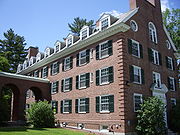 |
1929 | 78 | Lord Hall, named for trustee John K. Lord, was built alongside Streeter Hall for a combined $297,000. | |
| Streeter Hall |  |
1929 | 67 | Streeter Hall, named for trustee General Frank Streeter, was built alongside Gile Hall for a combined $297,000. The ground floor was remodeled in 1989 to include a kitchen and lounge. |
Massachusetts Row Cluster
The "Mass Row" cluster is popular for its convenient location to Thayer Dining Hall and the Collis Center. It houses only upperclass students.| Building | Image | Constructed | Capacity | Notes | Reference |
|---|---|---|---|---|---|
| Hitchcock Hall |  |
1913 | 86 | Named for the Hitchcock Estate on which it was built, Hitchcock Hall served briefly as a barracks in 1918. It opened in January 2008 for Winter Term after undergoing extensive renovation and remodeling. | |
| Massachusetts Hall |  |
1907 | 111 | Generally called "Mid Mass," this dormitory cost $80,000 to build. Notable past residents include U.S. Surgeon General C. Everett Koop C. Everett Koop Charles Everett Koop, MD is an American pediatric surgeon and public health administrator. He was a vice admiral in the Public Health Service Commissioned Corps, and served as thirteenth Surgeon General of the United States under President Ronald Reagan from 1982 to 1989.-Early years:Koop was born... '37 in room 310, television host Fred Rogers '50 in room 101, and football coach Dave Shula Dave Shula David Donald Shula is a former American football player and coach. The son of famed National Football League coach Don Shula and brother of Mike Shula, he now works with his father in the family's restaurant business, Shula's Steak Houses.... '81 in room 107. |
|
| North Massachusetts Hall |  |
1912 | 68 | "North Mass" was once home to U.S. Congressman Paul Tsongas Paul Tsongas Paul Efthemios Tsongas was a United States Senator from Massachusetts from 1979 to 1985. He was an unsuccessful candidate for the Democratic nomination in the 1992 presidential election. He previously served as a U.S... '62 in room 301. |
|
| South Massachusetts Hall |  |
1912 | 68 | "South Mass" functioned as a sick bay for the Naval Training School that operated at Dartmouth during World War II. Notable past residents include actor Andrew Shue Andrew Shue Andrew Eppley Shue is an American actor, known for his role as Billy Campbell on the television series Melrose Place . He is currently on the Board of Directors for Do Something and is the co-founder of the social networking website CafeMom.-Early life:Shue was born in Wilmington, Delaware... '89 in room 305. |
McLaughlin Cluster
The McLaughlin Cluster, named for former Dartmouth president David T. McLaughlinDavid T. McLaughlin
David Thomas McLaughlin was the 14th President of Dartmouth College, 1981–1987. Mr. McLaughlin also served as Chief Executive Officer of Orion Safety Products from 1988 to December 31, 2000. He was President and Chief Executive Officer of the Aspen Institute from 1988 to 1997 and its...
'54, Tu '55, consists of six buildings and houses 342 students. It cost more than $41 million to build. Located in Goldstein Hall is Occom Commons, a community space described as "state-of-the-art." The cluster earned silver certification from the U.S. Green Building Council LEED program for its environmentally friendly design.
| Building | Image | Constructed | Capacity | Reference |
|---|---|---|---|---|
| Berry Hall |  |
2004–2006 | 43 | |
| Bildner Hall |  |
2004–2006 | 61 | |
| Byrne Hall II |  |
2004–2006 | 49 | |
| Goldstein Hall |  |
2004–2006 | 39 | |
| Rauner Hall |  |
2004–2006 | 75 | |
| Thomas Hall |  |
2004–2006 | 75 |
Ripley-Woodward-Smith Cluster
This cluster, known as "RipWoodSmith," cost $260,000 to build in 1930. Its buildings are named for three of the earliest tutors at the College: Sylvanus Ripley, Bezaleel Woodward, and John Smith. Women were not permitted to live in Ripley or Smith until 1989, although Woodward served as one of two exclusively women's dorms until the same year.| Building | Image | Constructed | Capacity | Notes | Reference |
|---|---|---|---|---|---|
| Ripley Hall |  |
1930 | 45 | ||
| Smith Hall |  |
1930 | 47 | Notable past residents include Robert Reich Robert Reich Robert Bernard Reich is an American political economist, professor, author, and political commentator. He served in the administrations of Presidents Gerald Ford and Jimmy Carter and was Secretary of Labor under President Bill Clinton from 1993 to 1997.... '68, who lived in room 208 during his freshman year. |
|
| Woodward Hall |  |
1930 | 45 |
The River Cluster
Originally known as "the Wigwams," the River Cluster is so named for its location near the banks of the Connecticut RiverConnecticut River
The Connecticut River is the largest and longest river in New England, and also an American Heritage River. It flows roughly south, starting from the Fourth Connecticut Lake in New Hampshire. After flowing through the remaining Connecticut Lakes and Lake Francis, it defines the border between the...
. The all-freshman portion of the River dorms now comprises only two dormitories, with Hinman Hall being demolished to make way for the Tuck LLC (see below). The other two are apartment facilities.
| Building | Image | Constructed | Capacity | Notes | Reference |
|---|---|---|---|---|---|
| Channing Cox Hall |  |
1976 | 68 | Channing Cox, along with Maxwell Hall, is an apartment facility. | |
| French Hall |  |
1958–1962 | 98 | French Hall is an all-freshman dorm and was remodeled in 1985. | |
| Judge Hall |  |
1958–1962 | 87 | Judge Hall, formerly McLane Hall, is one of two all-freshmen dormitories in the River. | |
| Maxwell Hall |  |
1982 | 68 | Maxwell, along with Channing Cox, is an apartment facility. |
Russell Sage Cluster
The Russell Sage Cluster sits between Tuck Mall and Webster Avenue on land from the 45 acres (18.2 ha) 1912 donation of the Hitchcock Estate to the College. The Tuck Mall Residence Halls, Fahey and McLane, were added in 2006 at the collective cost of $19 million.| Building | Image | Constructed | Capacity | Notes | Reference |
|---|---|---|---|---|---|
| Butterfield Hall |  |
1940 | 55 | Butterfield was named for philanthropist Ralph Butterfield (class of 1839), who donated the school's natural history museum (since demolished). It was the last pre-World War II dormitory constructed at Dartmouth. The Hyphen, a lounge constructed in 1988-1989, connects Butterfield to Russell Sage Hall. | |
| Fahey Hall |  |
2005–2006 | 62 | ||
| McLane Hall |  |
2005–2006 | 99 | ||
| Russell Sage Hall |  |
1922–1923 | 119 | Russell Sage is the oldest building of the cluster, named after the Russell Sage Foundation Russell Sage Foundation The Russell Sage Foundation is the principal American foundation devoted exclusively to research in the social sciences. Founded in 1907 and headquartered in New York City, the foundation is a research center, a funding source for studies by scholars at other institutions, and a key member of the... and designed in part by architect John Russell Pope John Russell Pope John Russell Pope was an architect most known for his designs of the National Archives and Records Administration building , the Jefferson Memorial and the West Building of the National Gallery of Art in Washington, DC.-Biography:Pope was born in New York in 1874, the son of a successful... . The Hyphen, a lounge constructed in 1988-1989, connects Russell Sage to Butterfield Hall. |
Topliff-New Hampshire Cluster
| Building | Image | Constructed | Capacity | Notes | Reference |
|---|---|---|---|---|---|
| The Lodge |  |
1961 | 72 | The Lodge was originally the Hanover Inn Motor Lodge, located on Lebanon Street in downtown Hanover. It was converted for student use in 1974. | |
| New Hampshire Hall |  |
1908 | 120 | New Hampshire Hall, known as "New Hamp", cost $80,000 to build. It was remodeled in 1928-1930, and will undergo complete renovation starting in 2008. Notable past residents include Reggie Williams Reggie Williams (linebacker) Reginald Williams is a former professional American football player.The recipient of an academic scholarship, Williams was a three-time All-Ivy League linebacker in football and an Ivy League heavyweight wrestling champion at Dartmouth College, graduating in 1976 with a Bachelor of Arts in... '76 who lived in room 211 during his freshman year. |
|
| Topliff Hall |  |
1920 | 174 | Named for benefactor Elijah M. Topliff, this residence hall cost $355,000 to build. It was built to accommodate the post-World War I influx of students, and when constructed, was the largest dormitory on campus. Notable past residents include Dr. Seuss Dr. Seuss Theodor Seuss Geisel was an American writer, poet, and cartoonist most widely known for his children's books written under the pen names Dr. Seuss, Theo LeSieg and, in one case, Rosetta Stone.... (Theodor Geisel) '25 in room 416 and Louise Erdrich Louise Erdrich Karen Louise Erdrich, known as Louise Erdrich, is an author of novels, poetry, and children's books featuring Native American heritage. She is widely acclaimed as one of the most significant writers of the second wave of what critic Kenneth Lincoln has called the Native American Renaissance... '76 in room 303. |
Wheeler-Richardson Cluster
| Building | Image | Constructed | Capacity | Notes | Reference |
|---|---|---|---|---|---|
| Richardson Hall |  |
1897–1898 | 63 | Richardson is the oldest building on campus still used as a residence hall. It cost $49,013 to build. Room 108 housed the unofficial headquarters of Dartmouth Outing Club Dartmouth Outing Club The Dartmouth Outing Club is the oldest and largest collegiate outing club in the United States. Proposed in 1909 by Dartmouth College student Fred Harris to "stimulate interest in out-of-door winter sports", the club soon grew to encompass the College's year-round outdoor recreation and has had... sub-group Cabin & Trail from 1968 to 1982. |
|
| Wheeler Hall |  |
1905 | 106 | Wheeler Hall cost $83,135 to build. It was featured in a 1974 Pepsi Pepsi Pepsi is a carbonated soft drink that is produced and manufactured by PepsiCo... commercial centering around the College's Winter Carnival tradition. |
Greek houses and other undergraduate societies
| Building | Image | Constructed | Notes | Reference |
|---|---|---|---|---|
| Alpha Chi Alpha Alpha Chi Alpha Alpha Chi Alpha is a fraternity at the American Ivy League university of Dartmouth College. Alpha Chi Alpha is a member of Dartmouth's Greek system, which currently has fourteen fraternities, nine sororities and three co-ed undergraduate houses that fall under the umbrella of the Greek... |
 |
1896 | The Alpha Chi Alpha house was built and owned by the Emery family before being occupied by Alpha Chi Rho Alpha Chi Rho Alpha Chi Rho is a men's collegiate fraternity founded on June 4, 1895 at Trinity College in Hartford, Connecticut by the Reverend Paul Ziegler, his son Carl Ziegler, and Carl's friends William Rouse, Herbert T. Sherriff and William A.D. Eardeley. It is a charter member of the North-American... fraternity between 1956 and 1961. In 1963, the organization became Alpha Chi Alpha. |
|
| Alpha Delta |  |
192X | Alpha Delta Phi Alpha Delta Phi Alpha Delta Phi is a Greek-letter social college fraternity and the fourth-oldest continuous Greek-letter fraternity in the United States and Canada. Alpha Delta Phi was founded on October 29, 1832 by Samuel Eells at Hamilton College and includes former U.S. Presidents, Chief Justices of the U.S.... built this house to replace their prior home on the same plot. In 1969, the name was changed to Alpha Delta. |
|
| Alpha Theta | 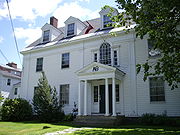 |
1940–1941 | The Alpha Theta house, built by AΘ's predecessor fraternity Theta Chi Theta Chi Theta Chi Fraternity is an international college fraternity. It was founded on April 10, 1856 as the Theta Chi Society, at Norwich University, Norwich, Vermont, U.S., and was the 21st of the 71 North-American Interfraternity Conference men's fraternities.-Founding and early years at Norwich:Theta... , was a replacement for an older building whose furnace leaked, killing nine house members. |
|
| Amarna | 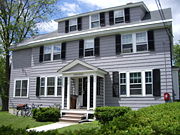 |
192X | Amarna, a College undergraduate society, moved into this house on East Wheelock Street in 1993. | |
| Beta Alpha Omega | 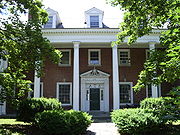 |
1931 | After being removed from campus in 1997, Beta Theta Pi Beta Theta Pi Beta Theta Pi , often just called Beta, is a social collegiate fraternity that was founded in 1839 at Miami University in Oxford, Ohio, USA, where it is part of the Miami Triad which includes Phi Delta Theta and Sigma Chi. It has over 138 active chapters and colonies in the United States and Canada... was reformed as Beta Alpha Omega in the fall of 2008, re-occupying its house after renting it to sorority Alpha Xi Delta Alpha Xi Delta Alpha Xi Delta is a women's fraternity founded on April 17, 1893 at Lombard College, Galesburg, Illinois. Alpha Xi Delta is one of the oldest women's fraternities as well as one of the ten founding fraternities of the National Panhellenic Conference... during its time off-campus. |
|
| Bones Gate | 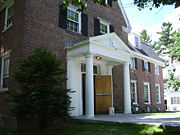 |
1925 | Bones Gate, formerly Delta Tau Delta Delta Tau Delta Delta Tau Delta is a U.S.-based international secret letter college fraternity. Delta Tau Delta was founded in 1858 at Bethany College, Bethany, Virginia, . It currently has around 125 student chapters nationwide, as well as more than 25 regional alumni groups. Its national community service... , moved into this house from an older structure on North Main Street. It was rebuilt following a fire in 1929. |
|
| Casque and Gauntlet Casque and Gauntlet Casque and Gauntlet is the second-oldest of the eight senior societies at Dartmouth College. C&G was founded in 1886, just after the Sphinx, and moved to its current location at 1 South Main Street in 1893... |
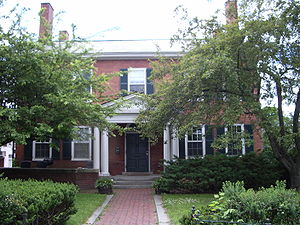 |
1823 | This house at 1 South Main Street houses Casque & Gauntlet, a senior society founded in 1886. | |
| Chi Gamma Epsilon Chi Gamma Epsilon Chi Gamma Epsilon is a fraternity at Dartmouth College. "Chi Gam," as it is commonly known, was formerly part of the Kappa Sigma fraternity, before breaking off for political reasons. On campus, Chi Gam is known for its dance parties, its house pong game known as ship and its commitment to... |
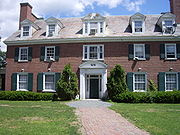 |
1937 | Kappa Sigma Kappa Sigma Kappa Sigma , commonly nicknamed Kappa Sig, is an international fraternity with currently 282 active chapters and colonies in North America. Kappa Sigma has initiated more than 240,000 men on college campuses throughout the United States and Canada. Today, the Fraternity has over 175,000 living... , later Chi Gamma Epsilon, built this structure as a replacement for their 1915 building. |
|
| Chi Heorot Chi Heorot Chi Heorot is a local fraternity at Dartmouth College located in Hanover, NH.-History:Heorot was founded in 1897 as a local fraternity called Alpha Alpha Omega. In 1902 it was granted a charter as the Chi chapter of Chi Phi... |
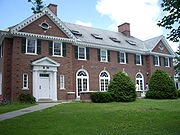 |
1929 c. | The Chi Heorot house at 11 East Wheelock Street was built to replace their 1795 structure. | |
| Cobra Hall |  |
1898-1915 ca. | This College-owned house at 13 Summer Street served as Dartmouth's Hillel house before the Roth Center for Jewish Life was finished in 1998. It is now used by Cobra, a women's senior society founded in 1979. | |
| Delta Delta Delta Delta Delta Delta Delta Delta Delta , also known as Tri Delta, is an international sorority founded on November 27, 1888, the eve of Thanksgiving Day. With over 200,000 initiates, Tri Delta is one of the world's largest NPC sororities.-History:... |
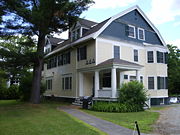 |
1898 | The Delta Delta Delta Delta Delta Delta Delta Delta Delta , also known as Tri Delta, is an international sorority founded on November 27, 1888, the eve of Thanksgiving Day. With over 200,000 initiates, Tri Delta is one of the world's largest NPC sororities.-History:... house was built as a faculty duplex, and its halves were variously occupied by Alpha Phi Alpha fraternity and College substance-free housing. Tri-Delt occupied the house around 1992, and its two halves were joined around 1994. |
|
| Dragon Society Dragon Society The Dragon Society or Society of Dragons is a secret society of senior men at Dartmouth College in Hanover, New Hampshire, United States. The group's membership and organizational structure are unknown... |
 |
1995–1996 | The Dragon Society's former tomb was demolished to make way for Berry Library, and the College helped build this one as replacement. It stands on a hill overlooking College Street. | |
| Epsilon Kappa Theta | 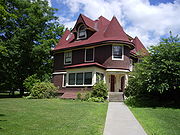 |
1896 | This house was built for a professor and was leased to the Mary Hitchock Memorial Hospital School of Nursing during the 1940s. After being occupied by a number of failed coeducational societies, it was obtained by the College. EKT began renting it in 1991. | |
| Fire & Skoal House |  |
1893-1896 ca. | Fire & Skoal, a senior society, has occupied this building on Park Street since 1984. | |
| Gamma Delta Chi | 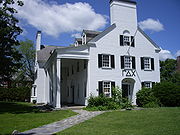 |
1936 ca. | This house was built following the merger of two societies to form Gamma Delta Chi. The house has an underground basketball court underneath the porch. | |
| Kappa Delta Epsilon | 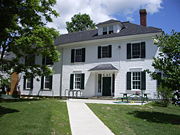 |
1898–1899 | Privately owned until 1950, the house was used as the initial location of the Foley House until Alpha Chi Omega Alpha Chi Omega Alpha Chi Omega is a women's fraternity founded on October 15, 1885. Currently, there are 135 chapters of Alpha Chi Omega at colleges and universities across the United States and more than 200,000 lifetime members... , eventually KDE, obtained it in 1980. |
|
| Kappa Kappa Gamma | 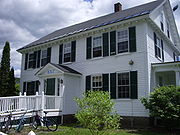 |
1842 | Originally standing on the site of the east entrance to Baker Library, this house was moved to its present location on East Wheelock Street in the 1920s. Kappa Kappa Gamma Kappa Kappa Gamma Kappa Kappa Gamma is a collegiate women's fraternity, founded at Monmouth College, in Monmouth, Illinois, USA. Although the groundwork of the organization was developed as early as 1869, the 1876 Convention voted that October 13, 1870 should be recognized at the official Founders Day, because no... has occupied it since before 1986. |
|
| Kappa Kappa Kappa Kappa Kappa Kappa Kappa Kappa Kappa is a local men's fraternity at Dartmouth College in Hanover, New Hampshire. The fraternity founded in 1842 is the second-oldest fraternity at Dartmouth College and the oldest local fraternity in the nation... |
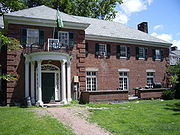 |
1925 | Tri-Kap's third residence, at 1 Webster Avenue, was funded by the College in return for the fraternity's property on the site of Silsby Hall. | |
| Panarchy | 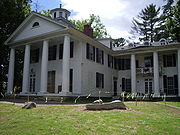 |
1835 | Panarchy resides in an off-campus house with a Doric temple front and cupola. It was bought in the early 20th century by a local fraternity whose descendant, Phi Sigma Psi, became the current undergraduate society of Panarchy around 1992. | |
| Phi Delta Alpha |  |
1902 | Phi Delta Theta was the first fratenity to establish itself on Webster Avenue. In 1960, its name changed to Phi Delta Alpha. | |
| Phi Tau Phi Tau Phi Tau is a coeducational fraternity at Dartmouth College in Hanover, New Hampshire, USA. Founded in 1905 as the Tau Chapter of Phi Sigma Kappa, the organization separated from the national fraternity in 1956 over a dispute regarding the segregationist and antisemitic membership policies of the... |
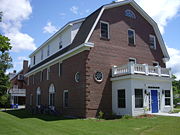 |
2002 | Phi Tau's current building was built as part of Dartmouth's construction of Berry Library and other north campus development. | |
| Psi Upsilon | 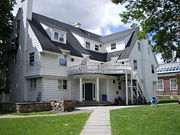 |
1908 | Psi Upsilon's house was constructed on an empty lot previously housing a local hatter. | |
| Sigma Alpha Epsilon Sigma Alpha Epsilon Sigma Alpha Epsilon is a North American Greek-letter social college fraternity founded at the University of Alabama on March 9, 1856. Of all existing national social fraternities today, Sigma Alpha Epsilon is the only one founded in the Antebellum South... |
 |
1931 | This structure replaced Sigma Alpha Epsilon's house on the same site. | |
| Sigma Delta Sigma Delta Sigma Delta is a local sorority at Dartmouth College in Hanover, New Hampshire, United States. First established on the campus in 1972, Sigma Delta, known as "Sigma Delt" by students, as a chapter of the national sorority Sigma Kappa. Dartmouth's Sigma Kappa chapter was the first sorority to be... |
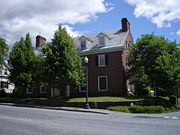 |
1936–1937 | Originally belonging to Phi Gamma Delta Phi Gamma Delta The international fraternity of Phi Gamma Delta is a collegiate social fraternity with 120 chapters and 18 colonies across the United States and Canada. It was founded at Jefferson College, Pennsylvania, in 1848, and its headquarters are located in Lexington, Kentucky, USA... fraternity, the College bought this structure in the 1970s and rented it to Dartmouth's first sorority, Sigma Kappa (later Sigma Delta). |
|
| Sigma Nu |  |
1925 | Sigma Nu's house at 12 Webster Avenue has undergone numerous alterations since its 1925 construction. | |
| Sigma Phi Epsilon Sigma Phi Epsilon Sigma Phi Epsilon , commonly nicknamed SigEp or SPE, is a social college fraternity for male college students in the United States. It was founded on November 1, 1901, at Richmond College , and its national headquarters remains in Richmond, Virginia. It was founded on three principles: Virtue,... |
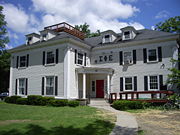 |
1896 | This house was privately owned until at least 1950; the College acquired the property from the Cardigan Mountain School Cardigan Mountain School Cardigan Mountain School is a boys-only independent boarding school located on 62 Alumni Drive, Canaan, New Hampshire, USA. It was founded in 1945 on land provided by Dartmouth College.... in 1953 and leased it to Sigma Phi Epsilon later that year. A wing was added in 1959. The fraternity purchased the property in 1964. In June 2010, the fraternity demolished the worn out and now inadequate building to make room for a new construction scheduled for completion at the end of 2010. |
|
| Sphinx Sphinx (senior society) The Sphinx, founded in 1885, is the oldest of the eight senior societies at Dartmouth College in Hanover, New Hampshire. Though sometimes also claimed to be the oldest all male secret society in the country, both the Flat Hat Club at the College of William and Mary and Sigma at Washington and Lee... |
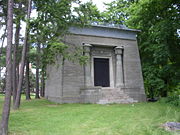 |
1903 | The Sphinx tomb on East Wheelock Street was designed by Manchester Manchester, New Hampshire Manchester is the largest city in the U.S. state of New Hampshire, the tenth largest city in New England, and the largest city in northern New England, an area comprising the states of Maine, New Hampshire, and Vermont. It is in Hillsborough County along the banks of the Merrimack River, which... architect William M. Butterfield. |
|
| The Tabard | 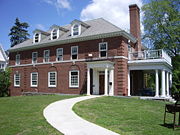 |
1932 | The Eta-Eta Chapter of Sigma Chi Sigma Chi Sigma Chi is the largest and one of the oldest college Greek-letter secret and social fraternities in North America with 244 active chapters and more than . Sigma Chi was founded on June 28, 1855 at Miami University in Oxford, Ohio when members split from Delta Kappa Epsilon... fraternity, a descendant of a Chandler School society, built this house to replace a previous burned structure. The fraternity adopted the name The Tabard, a reference to Chaucer's Canterbury Tales, on April 20, 1960, and became coeducational in the 1970s. |
|
| Theta Delta Chi | 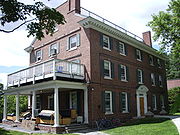 |
1925 | This house stands on land used by Eleazar Wheelock Eleazar Wheelock Eleazar Wheelock was an American Congregational minister, orator, educator, and founder of Dartmouth College.... for a garden. It was constructed in 1924 to replace the fraternity's earlier house on this site after it burned. |
|
| Zeta Psi | 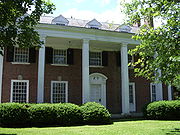 |
1925 | Zeta Psi began in 1853 but lapsed during the 1860s and late 19th century. It lost College recognition in 2001 but regained recognition in 2009. |
Dartmouth Medical School
The buildings of Dartmouth Medical SchoolDartmouth Medical School
Dartmouth Medical School is the medical school of Dartmouth College, located in Hanover, New Hampshire, in the United States. The fourth-oldest medical school in the United States, Dartmouth Medical School was founded in 1797 by New England physician Nathan Smith and grew steadily over the course...
are clustered on the north end of the Dartmouth campus, known as the "north campus."
| Building | Image | Constructed | Notes | Reference |
|---|---|---|---|---|
| 1 Rope Ferry Road |  |
1937 | 1 Rope Ferry Road, originally called the Hitchcock Clinic, was renamed after the Dartmouth-Hitchcock Medical Center Dartmouth-Hitchcock Medical Center Dartmouth-Hitchcock Medical Center is New Hampshire's only academic medical center and is headquartered on a campus in the heart of the Upper Connecticut River Valley, in Lebanon, New Hampshire.... moved from Hanover to the neighboring city of Lebanon Lebanon, New Hampshire As of the census of 2000, there were 12,568 people, 5,500 households, and 3,178 families residing in the city. The population density was 311.4 people per square mile . There were 5,707 housing units at an average density of 141.4 per square mile... . It now houses administrative offices of the Medical School, including the Dean's Office. |
|
| 3 Rope Ferry Road | 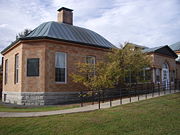 |
1893 | Formerly the Women's Ward of the Mary Hitchcock Memorial Hospital, 3 Rope Ferry Road now serves as the Medical School's Admissions department. | |
| Dana Biomedical Library | 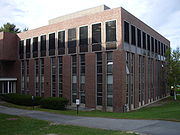 |
1963–1964 | Dana Biomedical Library, built with a grant from the Charles A. Dana Foundation, currently houses 240,000 volumes. | |
| Kellogg Auditorium |  |
1962 | Kellogg Auditorium is a Medical School meeting forum connected to Remsen by a skybridge. | |
| Remsen Medical Sciences Building |  |
1959–1960 | Remsen, along with Vail, is one of the two main buildings of the Medical School campus, housing offices, labs, and classrooms. | |
| James D. Vail Medical Sciences Building |  |
1971–1973 | Vail is an eight-story building which, along with Remsen, houses the Medical School's offices, labs, and classrooms. |
Thayer School of Engineering
The Thayer School of EngineeringThayer School of Engineering
Thayer School of Engineering is a graduate school at Dartmouth College, Hanover, New Hampshire, United States, whose faculty also double as the undergraduate Department of Engineering Sciences. The school was established in 1867 with funds from Brig. Gen...
is located adjacent to the Tuck School of Business
Tuck School of Business
The Amos Tuck School of Business Administration is the graduate business school of Dartmouth College in Hanover, New Hampshire, in the United States...
on the western edge of campus, near the Connecticut River
Connecticut River
The Connecticut River is the largest and longest river in New England, and also an American Heritage River. It flows roughly south, starting from the Fourth Connecticut Lake in New Hampshire. After flowing through the remaining Connecticut Lakes and Lake Francis, it defines the border between the...
. It currently comprises two buildings, and it shares the Murdough Center (listed under Tuck) with the Tuck School of Business.
| Building | Image | Constructed | Notes | Reference |
|---|---|---|---|---|
| Horace Cummings Memorial Hall |  |
1939 | This $200,000 building was built as the main facility of the Thayer School, with additional wings added in 1945-1947 and 1976. | |
| MacLean Engineering Sciences Center |  |
2004–2006 | Completed at a cost of just under $21 million, MacLean provides both research and teaching space for the Thayer School. |
Tuck School of Business
Like the Thayer School of Engineering, the Tuck School of BusinessTuck School of Business
The Amos Tuck School of Business Administration is the graduate business school of Dartmouth College in Hanover, New Hampshire, in the United States...
is located in a complex on the western side of campus, along the Connecticut River.
| Building | Image | Constructed | Notes | Reference |
|---|---|---|---|---|
| Buchanan Hall |  |
1968 | Originally called the "Tuck Mall Dorm," Buchanan is a Tuck dormitory. It contains 68 singles and five suites. | |
| Byrne Hall |  |
1992 | Byrne Hall is a dining facility operated by Dartmouth Dining Services. | |
| Chase Hall |  |
1930 | Named for College alumnus Salmon P. Chase Salmon P. Chase Salmon Portland Chase was an American politician and jurist who served as U.S. Senator from Ohio and the 23rd Governor of Ohio; as U.S. Treasury Secretary under President Abraham Lincoln; and as the sixth Chief Justice of the United States Supreme Court.Chase was one of the most prominent members... , Chase was originally built as a dormitory. Now, it contains the Tuck School's admissions and financial aid offices, as well as some faculty offices. |
|
| Murdough Center |  |
1973 | The Murdough Center is shared by the Tuck School and the Thayer School. In addition to lecture halls and some offices, the Center houses the Feldberg Business and Engineering Library. | |
| Stell Hall |  |
1930 | Stell was originally a refectory Refectory A refectory is a dining room, especially in monasteries, boarding schools and academic institutions. One of the places the term is most often used today is in graduate seminaries... , but upon the completion of Byrne Hall in the early 1990s, it was converted to a common space for students, faculty and staff. |
|
| Tuck Hall |  |
1930 | Tuck Hall serves as the main administrative building of the Tuck School. | |
| Tuck Living and Learning Complex | 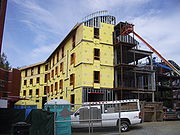 |
2007–present | The Tuck Living and Learning Complex (LLC) is primarily a residential facility that will also contain three classrooms and more than a dozen study rooms. It is expected to be ready for occupancy in December 2008. | |
| Whittemore Hall | 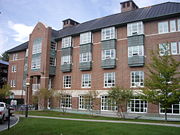 |
1999–2000 | Whittemore Hall is a dormitory for Tuck students, housing 60 first-year students. | |
| Woodbury Hall |  |
1930 | Woodbury Hall, originally built as a dormitory, was converted to office space in the late 1980s. It contains Tuck's five research centers. |
Athletic and outdoor recreation buildings
| Building | Image | Constructed | Notes | Reference |
|---|---|---|---|---|
| Alumni Gymnasium | 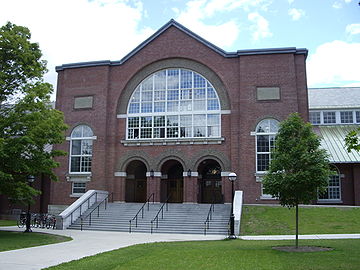 |
1909–1910 | Alumni Gymnasium serves as the center of Dartmouth's athletic facilities and includes two pools, a fitness center, a weight room, and an indoor track. It has undergone numerous remodelings, most recently in 2006. | |
| Berry Sports Center |  |
1987 | The Berry Sports Center holds racquetball and basketball facilities (Edward Leede Arena Leede Arena Edward Leede Arena is a 2,100-seat, multi-purpose arena in Hanover, New Hampshire. Built in 1986, it is home to the Dartmouth College Big Green basketball team. It is located within the John W... ). |
|
| Boss Tennis Center |  |
2000 | The Alexis Boss Tennis Center, located behind Thompson Arena, contains six regulation tennis courts. The attached Alan Gordon Pavilion provides locker rooms and a lounge. | |
| Davis Field House |  |
1926 | Davis Field House, which overlooks the Memorial Field track, is a facility for varsity athletic teams. | |
| Floren Varsity House |  |
2006–2007 | Floren, which opened in the fall of 2007, contains a strength training center, a sports classroom, meeting rooms, locker rooms, equipment storage, and team offices. | |
| Friends of Dartmouth Rowing Boathouse |  |
1998–1999 | The Boathouse, sitting on the banks of the Connecticut River Connecticut River The Connecticut River is the largest and longest river in New England, and also an American Heritage River. It flows roughly south, starting from the Fourth Connecticut Lake in New Hampshire. After flowing through the remaining Connecticut Lakes and Lake Francis, it defines the border between the... north of the Ledyard Bridge Ledyard Bridge The Ledyard Bridge crosses the Connecticut River to connect Hanover, New Hampshire to Norwich, Vermont. It is the third bridge at this crossing to bear the name of the adventurer John Ledyard.-History:... , can store 30 rowing shells. |
|
| Ledyard Canoe Club |  |
1920 | The building housing the Club sits along the Connecticut River and includes storage space for canoes, as well as a meeting room and kitchen. | |
| Leverone Field House |  |
1962–1963 | Designed by Italian architect Pier Luigi Nervi Pier Luigi Nervi Pier Luigi Nervi was an Italian engineer. He studied at the University of Bologna and qualified in 1913. Dr. Nervi taught as a professor of engineering at Rome University from 1946-61... , Leverone contains an indoor track and tennis courts. |
|
| Memorial Field | 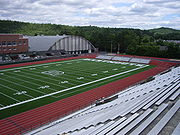 |
1921–1923 | Memorial Field, Dartmouth's football and track & field stadium, was erected on the site of previous athletic grandstand built in 1893. It is named in memory of the Dartmouth alumni who died in World War I World War I World War I , which was predominantly called the World War or the Great War from its occurrence until 1939, and the First World War or World War I thereafter, was a major war centred in Europe that began on 28 July 1914 and lasted until 11 November 1918... . |
|
| Thompson Arena Thompson Arena Rupert C. Thompson Arena is a 3,500-seat hockey arena in Hanover, New Hampshire. It is home to the Dartmouth College Big Green men's and women's ice hockey teams. The barrel-vaulted, reinforced concrete arena was designed by renowned architect Pier Luigi Nervi. It was named for Rupert C... |
 |
1975 | Thompson Arena, Dartmouth's hockey facility, was also designed by Pier Luigi Nervi Pier Luigi Nervi Pier Luigi Nervi was an Italian engineer. He studied at the University of Bologna and qualified in 1913. Dr. Nervi taught as a professor of engineering at Rome University from 1946-61... . |
|
| Tom Dent Cabin |  |
1940 | Tom Dent Cabin is a recreational cabin standing along the Connecticut River near the Ledyard Canoe Club. |
Other facilities
| Building | Image | Constructed | Notes | Reference |
|---|---|---|---|---|
| 5 Rope Ferry Road |  |
1913 | 5 Rope Ferry Road contained the maternity ward of the Mary Hitchcock Memorial Hospital. It is now home to the Department of Safety & Security, Dartmouth's campus police force. | |
| 13 East Wheelock Street |  |
18XX | 13 East Wheelock Street was bought by the College at some point between 1950 and 1961. Since around 1997, it has been used as housing for faculty associated with the East Wheelock cluster. | |
| 37 Dewey Field Road |  |
1936–1937 | 37 Dewey Field Road was built as part of the MHMH School of Nursing. It now contains the IT department and technical support. | |
| Aquinas House |   |
1961–1962 | Aquinas House is the independent Catholic Students' Center, located at the end of Webster Avenue. | |
| Bartlett Tower |  |
1885–1895 | Bartlett Tower is a 71 feet (21.6 m) prospect tower located on a hill in the northeast corner of campus. It was erected by Dartmouth students over the course of ten years. | |
| Blunt Alumni Center |  |
1810 ca. | The oldest part of the Blunt Alumni Center was a house built by Professor Zephaniah Swift Moore Zephaniah Swift Moore Zephaniah Swift Moore was an American Congregational clergyman and educator. He taught at Dartmouth College during the early 1810s and had a house built in Hanover, New Hampshire that now serves as Dartmouth's Blunt Alumni Center... . It was bought by the College in 1884 and served as a dormitory called the Crosby House from 1896 until 1949, when the Alumni Records department moved in. Several additions have been added to the original house. Crosby House, the original structure built by Moore, is the oldest house in Hanover that remains on its original foundation. The Blunt Alumni Center also houses the Rassias Foundation. |
|
| Choate House |  |
1786 | Choate House, originally standing near today's Webster Hall, was inhabited by a number of College professors and private owners before being sold to the College in 1910. It was modernized and moved several times, finally to its current location on North Main Street. It briefly housed part of the Mathematics Department. | |
| Collis Center |  |
1901–1902 | The Collis Center was constructed on the site of the burned Balch House, of which only the granite steps out front remain. Originally called "College Hall," it was expanded in 1993 to its current form. It serves as a student center and contains a café. | |
| Dartmouth Outing Club House |  |
1928 | Standing on the north end of Occom Pond, the Dartmouth Outing Club Dartmouth Outing Club The Dartmouth Outing Club is the oldest and largest collegiate outing club in the United States. Proposed in 1909 by Dartmouth College student Fred Harris to "stimulate interest in out-of-door winter sports", the club soon grew to encompass the College's year-round outdoor recreation and has had... House is the DOC's Cross Country Ski Center and equipment rental location. |
|
| Dean of the College House |  |
1917 or later | This house, standing at 9 Choate Road, houses the current Dean of the College. It was formerly privately owned, and once held Aquinas House's functions. | |
| Dick's House |  |
1927 | Officially "Dick Hall's House," it is the College infirmary. | |
| Edgerton House |  |
1960 | Edgerton House is the Episcopal Episcopal Church (United States) The Episcopal Church is a mainline Anglican Christian church found mainly in the United States , but also in Honduras, Taiwan, Colombia, Ecuador, Haiti, the Dominican Republic, Venezuela, the British Virgin Islands and parts of Europe... students' center. |
|
| Fairbanks Hall North |  |
1925 | Fairbanks North originally held the Clark School gymnasium and stood on North Main Street before being moved to its current location and being adjoined to Fairbanks South. | |
| Fairbanks Hall South |  |
1903–1904 | Fairbanks South was built as the home of Beta Theta Pi fraternity. It is currently used by the William Jewett Tucker William Jewett Tucker The Rev. William Jewett Tucker served as the 9th President of Dartmouth College in New Hampshire, United States, from 1893 to 1909.- Dartmouth presidency :... Foundation for Community Service. |
|
| Hallgarten Hall |  |
1873–1874 | Hallgarten Hall was a dormitory for the New Hampshire College of Agriculture and the Mechanic Arts New Hampshire College of Agriculture and the Mechanic Arts New Hampshire College of Agriculture and the Mechanic Arts was founded and incorporated in 1866, as a land grant college in Hanover in connection with Dartmouth College... . It was purchased by Dartmouth in 1892 and served as a dorm until 1919, when it was used as an infirmary. It now holds the Bregman Electronic Music Studio. |
|
| Hanover Inn |  |
1887 | The Hanover Inn is a College-owned hotel overlooking the College Green. | |
| Hood Museum of Art Hood Museum of Art The Hood Museum of Art is a museum in Hanover, New Hampshire, USA. Dating back to 1772, the museum is owned and operated by Dartmouth College and is connected to the Hopkins Center for the Arts. The current building, designed by Charles Willard Moore and Chad Flloyd, opened in the fall of 1985. It... |
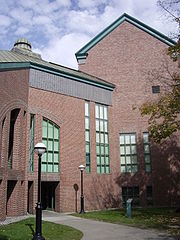 |
1981–1983 | The museum was previously housed in Carpenter, but it outgrew that space in the 1950s. The current 37000 square feet (3,437.4 m²) Hood Museum was funded by Trustee Harvey Hood in 1978. | |
| McKenzie Hall |  |
1931 ca. | McKenzie Hall is the home of Dartmouth's Facilities Operations & Management (FO&M) Department. It was originally constructed as a milk pasteurization Pasteurization Pasteurization is a process of heating a food, usually liquid, to a specific temperature for a definite length of time, and then cooling it immediately. This process slows microbial growth in food... plant. |
|
| Montgomery House |  |
1925 | Montgomery House along Rope Ferry Road houses visiting Montgomery Fellows. | |
| Parker House |  |
1917 | Parker House in the ravine behind College Street currently houses various College offices. | |
| President's House |  |
1926 | The President's House stands on Webster Avenue along with twelve of Dartmouth's fraternities and sororities. | |
| Robinson Hall | 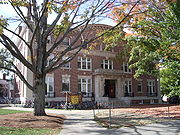 |
1913–1914 | Robinson Hall is the home of a variety of student organizations, including The Dartmouth The Dartmouth The Dartmouth is the daily student newspaper at Dartmouth College. Founded in 1799, it is America's oldest college newspaper. It is published by The Dartmouth, Inc., an independent, nonprofit corporation chartered in the state of New Hampshire.-History:... , the Dartmouth Jack-O-Lantern Dartmouth Jack-O-Lantern The Dartmouth Jack-O-Lantern is a college humor magazine, founded at Dartmouth College in 1908.The Jacko publishes print issues approximately four times a year, as well as regularly updated online content and occasional video productions... , the Dartmouth Outing Club Dartmouth Outing Club The Dartmouth Outing Club is the oldest and largest collegiate outing club in the United States. Proposed in 1909 by Dartmouth College student Fred Harris to "stimulate interest in out-of-door winter sports", the club soon grew to encompass the College's year-round outdoor recreation and has had... , and Dartmouth Broadcasting Dartmouth Broadcasting Dartmouth Broadcasting began in 1920s with the ambitions of a few Dartmouth College students that decided to give a new technology called radio a try. The first broadcast occurred over copper wires linked in all the dorms. The station used the call letters WDBS... . |
|
| Rollins Chapel | .jpg) |
1884–1885 | Rollins Chapel is Dartmouth's nondenominational chapel. | |
| Roth Center for Jewish Life |  |
1996–1997 | The Roth Center is a center for the Jewish community of Dartmouth and the surrounding area. | |
| Thayer Dining Hall |  |
1937 | Thayer Dining Hall is the center of student meal service, containing five dining operations. | |
| Webster Cottage |  |
1780 | Webster Cottage was, according to oral tradition, the home of student Daniel Webster Daniel Webster Daniel Webster was a leading American statesman and senator from Massachusetts during the period leading up to the Civil War. He first rose to regional prominence through his defense of New England shipping interests... during his senior year at Dartmouth. It passed through a variety of private hands, and now houses the Hanover Historical Society. |
Planned buildings
| Building | Scheduled | Notes | Reference |
|---|---|---|---|
| Class of 1953 Commons | 2010–2011 | The remodeling of Thayer Dining Hall. | |
| Class of 1978 Life Sciences Center | 2009–2012 | The new Life Sciences Building in the North Campus by the Dartmouth Medical School will replace Gilman Life Sciences Building. It will cost $93 million, and will be built on the land which now contains Strasenburgh, the Modular Laboratory, and Butler Hall. Bohlin Cywinski Jackson are the architects. | |
| Visual Arts Center | 2010–2011 | This new building for the Departments of Studio Art and Film & Television Studies will face Lebanon Street and replace Brewster and Clement Halls. Machado and Silvetti Machado and Silvetti Associates Machado and Silvetti Associates is an architecture and urban design firm headquartered in Boston, Massachusetts. Incorporated in 1985, the firm's principals Rodolfo Machado and Jorge Silvetti have been in association since 1974... are the architects. |

